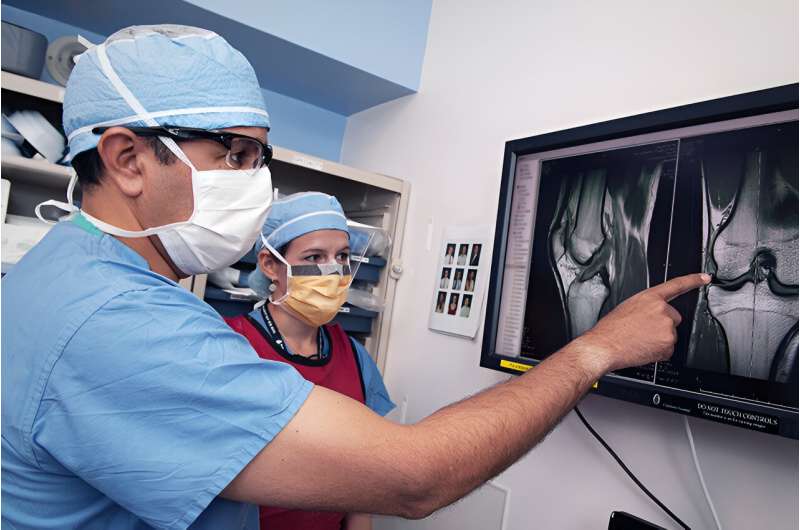This article has been reviewed according to Science X's editorial process and policies. Editors have highlighted the following attributes while ensuring the content's credibility:
fact-checked
trusted source
proofread
Researchers address uncertainty around ACL treatment decisions in young athletes

It's an injury once seen mainly in adults, yet it's become increasingly common in younger patients. From 2000 to 2020, the number of anterior cruciate ligament (ACL) tears in children and adolescents increased between three- and five-fold. For young athletes, an ACL tear spells six to nine months of downtime, heightened risk for secondary ACL injury, and the risk of early osteoarthritis.
Not surprisingly, pediatric orthopedic surgeons like Mininder Kocher, MD, MPH, are alarmed. "The majority of ACL surgeries in this country are not performed on 20- and 30-year-olds," says the chief of the Sports Medicine Division at Boston Children's Hospital. "They're done on older adolescents."
How does age affect ACL recovery?
As the rate of ACL tears in preteens and teens climbs, so too does the need for reliable data on treatment risks and outcomes in patients of different ages and stages of development. In choosing one of the four surgical techniques commonly used in prepubescent or adolescent patients, orthopedic surgeons don't have reliable data to answer questions such as:
- Which technique has the best outcomes based on a patient's age and gender?
- Does a patient's age or stage of growth affect their recovery?
- Does delaying surgery lead to better or worse outcomes?
- How do other associated injuries affect a patient's treatment and recovery?
To address the many gaps in knowledge around pediatric ACL injury, the International Olympic Committee (IOC) in 2017 convened a committee of pediatric sports medicine leaders. Kocher was one of them. "We've published studies of the surgical techniques used at Boston Children's," he says. But "these were small studies conducted at a single institution."
The IOC committee agreed that the field needs prospective studies of large patient populations treated at numerous specialty centers to support informed treatment decisions. They summarized this and other conclusions in a 2018 consensus statement on prevention, diagnosis, and management of ACL injuries.
A multicenter study is born
In response to the IOC committee's recommendations, Boston Children's launched PLUTO (Pediatric ACL: Understanding Treatment Options). PLUTO is a multicenter study group established to evaluate the safety and effectiveness of the most widely used treatments of ACL tears in pediatric patients.
The 10 participating centers recruited 749 skeletally immature (still growing) patients, aged 16 and under, who were treated for complete ACL tears between 2016 and 2020. Patients received one of five treatments:
- transphyseal ACL reconstruction
- physeal-sparing surgery (Anderson technique)
- physeal-sparing surgery (Micheli-Kocher technique)
- partial physeal-sparing surgery
- non-operative treatment
In addition to studying the efficacy of ACL treatment in pediatric patients, the PLUTO team is analyzing injury patterns and correlations between age and gender. They're also looking at how patients recover and whether certain age groups have higher rates of secondary injury compared to others.
Given that many adult patients develop osteoarthritis within 10 years of an ACL injury, PLUTO researchers plan to follow participants for 10 years or longer to gain insights into the long-term outlook for prepubescent and adolescent patients. They plan to publish the results of their two-year follow-up in 2024.
The future of ACL treatment and the importance of prevention
PLUTO is the first large-scale, prospective study to examine ACL treatments in pediatric patients. The 10 participating centers around the country aim to fill the current gap in evidence that orthopedic surgeons face when talking with young patients and their parents about treatment options.
By uncovering trends in the rate of retear after surgery, PLUTO may also play a role in reducing subsequent injuries in at-risk athletes through modified surgical techniques and rehabilitation protocols.
As much as Kocher looks forward to the ways in which high-quality data can advance ACL treatment, he and many others believe that preventing ACL injuries through heightened awareness is just as important.
"We've measured the psychosocial impact of receiving a diagnosis of ACL tear on adolescent athletes, and it's almost as devastating as a cancer diagnosis. Preventing these injuries from happening is fundamental to kids' well-being."

















